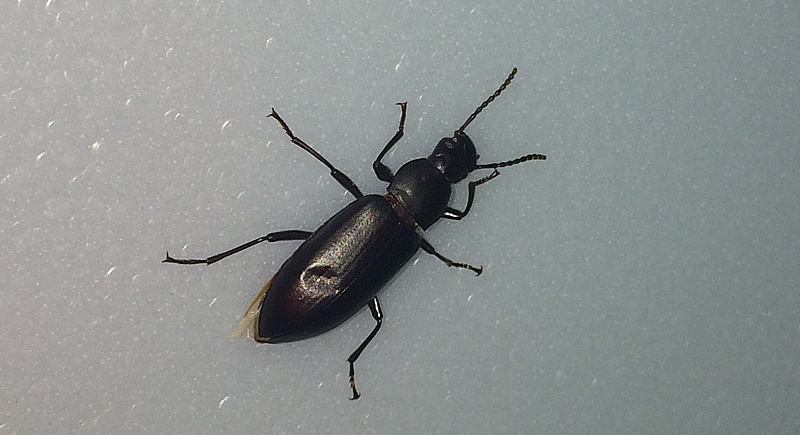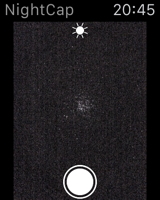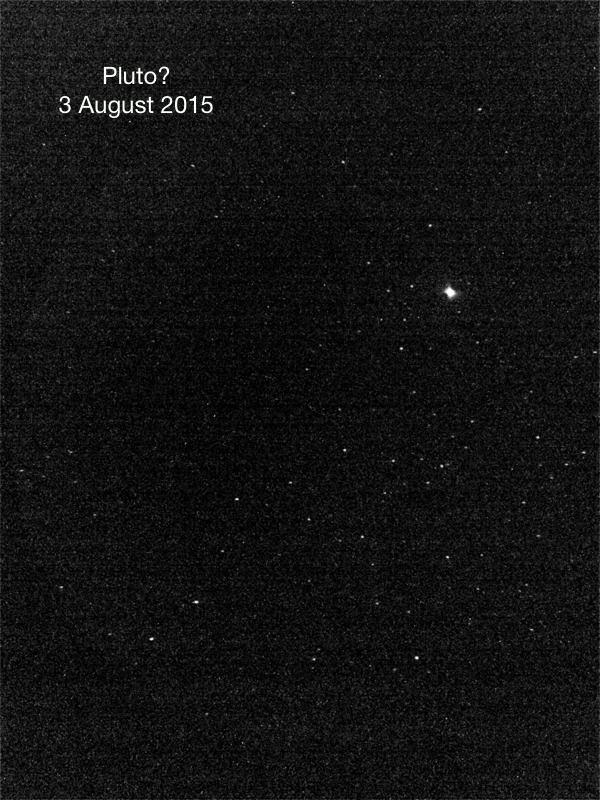iPhone Imaging: Venus, Saturn, M11, Pluto?; Visitors
Posted: 5 August 2015
|
Open: Tuesday, 4 August 2015, 1816 MST Temperature: 108°F |
Session: 854 Conditions: Mostly clear, breezy |
1822 MST: viewed Venus, 83X. Nice view of the thin crescent phase. Mounted the iPhone 5s on the 8" LX200-ACF using the MX-1 Afocal Adapter with a 9mm (222X) eyepiece. Did some slo-mo (120 fps) video recordings at 222X and 444X. This is a stack of 1766 frames (15 seconds) at 444X of the planet Venus:

And this is how a live view of Venus appeared on the Apple Watch:

1840 MST: resumed Venus observing, 83X. 1845 MST: viewed Jupiter, 83X, faintly visible with the equatorial belts barely visible. 1853 MST: viewed Saturn, 83X. Nice view against a blue sky, but low contrast. 1915 MST: Saturn at 166X was a nice crisp view. 1923 MST: sunset. Saturn was lovely at 166X.
The first of several visitors to Cassiopeia Observatory arrived:

Two of these grasshoppers kept coming into the observatory on the previous night and I kept evicting them, only to have them return again. Guess they want to be amateur astronomers.
Then did some iPhone slo-mo imaging of Saturn at 222X and 444X. This is a stack of 1756 frames (15 seconds) at 444X:

1945 MST: Saturn observing, 166X. The moons Titan and Rhea were visible. 1950 MST: the moons Tethys and Dione were just becoming visible. 1952 MST: back to using 83X; all four moons easily seen.
2001 MST: viewed M4 (globular cluster), 83X, faintly visible against twilight sky. Then evicted the grasshopper. Some clouds were now low in the southern sky. 2009 MST: the Milky Way was starting to be visible, 44 minutes before the end of Astronomical Twilight. 2011 MST: M4 stars were now visible.
2018 MST: viewed M11 (Wild Duck Cluster, open star cluster), 83X. Set up to do an iPhone image of M11 using the NightCap Pro app. Before starting to image M11 another visitor showed up:

He was escorted out of the observatory.
This is M11 (Wild Duck Cluster), iPhone 5s, afocal 77X, NightCap Pro (Long Exposure, Noise Reduction, ISO 8000, 1/2sec, 1 minute):

This is how M11 appeared live on the Apple Watch using NightCap Pro:

As I completed M11 iPhone imaging another visitor flew into the observatory past my head and landed on the observatory floor:

I tried to escort the Praying Mantis out of the observatory but she refused to leave (unfortunately, as it turned out).
2055 MST: slewed to Pluto (AutoStar) to prepare to image it with the iPhone for a confirming image to compare to the image from the previous night. Powered on the GC Wi-Fi Adapter and used SkySafari Pro to GOTO Pluto. This is how SkySafari Pro showed Pluto's position:

Somewhere near the center of this image is Pluto (if it was imaged as it was very faint), afocal 77X, NightCap Pro (Long Exposure, Light Boost, ISO 8000, 1/2sec, 1 minute):

I tried merging the above image with the one from the previous night:

Unfortunately, the two images would not align due to slight focal length differences (iPhone camera changing focus?) and image rotation. Try as I did I could not align the images, so was unable to confirm whether Pluto was imaged using the iPhone. (If anyone wants to try to align the images, please do and let me know the results.)
2119 MST: clouds were now visible in the south, southwest, and west. 2142 MST: after monitoring the cloud motion I decided to close for the night.
As I was closing the observatory I saw this struggle going on (the Praying Mantis lost):

|
Close: Tuesday, 4 August 2015, 2157 MST Temperature: 81°F |
Session Length: 03h 41m Conditions: Partly cloudy but increasing |
2015 is the 10th anniversary of my first visits to Oracle Observatory and I have been celebrating by posting reports from visits during 2005. Here is the report from 6 August 2005.
Comments are welcome using Email. If you are on Twitter you can use the button below to tweet this report to your followers. Thanks.
Cassiopeia Observatory Home Page
Copyright ©2015 Michael L. Weasner / mweasner@me.com
URL = http://www.weasner.com/co/Reports/2015/08/05/index.html
